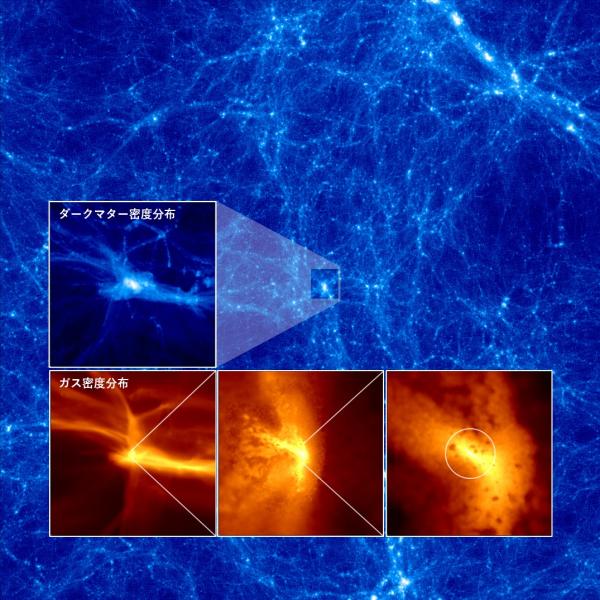September 29, 2017
Kavli Institute for the Physics and Mathematics of the Universe (Kavli IPMU)
 An international team of researchers has successfully used a super-computer simulation to recreate the formation of a massive black hole from supersonic gas streams left over from the Big Bang. Their study, published in this week’s Science, shows this black hole could be the source of the birth and development of the largest and oldest super-massive black holes recorded in our Universe.
An international team of researchers has successfully used a super-computer simulation to recreate the formation of a massive black hole from supersonic gas streams left over from the Big Bang. Their study, published in this week’s Science, shows this black hole could be the source of the birth and development of the largest and oldest super-massive black holes recorded in our Universe.
“This is significant progress. The origin of the monstrous black holes has been a long-standing mystery and now we have a solution to it,” said author and Kavli Institute for the Physics and Mathematics of the Universe (Kavli IPMU) Principal Investigator Naoki Yoshida.
Recent discoveries of these super-massive black holes located 13 billion light years away, corresponding to when the universe was just five per cent of its present age, pose a serious challenge to the theory of black hole formation and evolution. The physical mechanisms that form black holes and drive their growth are poorly understood.
Theoretical studies have suggested these black holes formed from remnants of the first generation of stars, or from a direct gravitational collapse of a massive primordial gas cloud. However, these theories either have difficulty in forming super-massive black holes fast enough, or require very particular conditions.
Yoshida and JSPS Overseas Research Fellow Shingo Hirano, currently at the University of Texas at Austin, identified a promising physical process through which a massive black hole could form fast enough. The key was incorporating the effect of supersonic gas motions with respect to dark matter. The team’s super-computer simulations showed a massive clump of dark matter had formed when the universe was 100 million years old. Supersonic gas streams generated by the Big Bang were caught by dark matter to form a dense, turbulent gas cloud. Inside, a protostar started to form, and because the surrounding gas provided more than enough material for it to feed on, the star was able to grow extremely big in a short amount of time without releasing a lot of radiation.
“Once reaching the mass of 34,000 times that of our Sun, the star collapsed by its own gravity, leaving a massive black hole. These massive black holes born in the early universe continued to grow and merge together to become a supermassive black hole,” said Yoshida.
The number density of massive black holes is derived to be approximately one per a volume of three billion light-years on a side – remarkably close to the observed number density of supermassive black holes,” said Hirano.
The result from this study will be important for future research into the growth of massive black holes. Especially with the increased number of black hole observations in the far universe that are expected to be made when NASA’s James Webb Space Telescope is launched next year.
This research was published in Science on September 28.
Aterui, one of the supercomputers this work used, is operated by the Center for Computational Astrophysics (CfCA) of the National Astronomical Observatory of Japan (NAOJ).


Paper Details:
Journal: Science September 28, 2017
Title: Supersonic Gas Streams Enhance the Formation of Massive Black Holes in the Early Universe
Authors: Shingo Hirano (1,2), Takashi Hosokawa (2,3,4), Naoki Yoshida (2,4,5), Rolf Kuiper (6)
Affiliations:
(1) Department of Astronomy, University of Texas, Austin, TX 78712, USA
(2) Department of Physics, School of Science, University of Tokyo, Bunkyo, Tokyo 113-0033, Japan
(3) Department of Physics, Kyoto University, Kyoto 606-8502, Japan
(4) Research Center for the Early Universe, University of Tokyo, Tokyo 113-0033, Japan
(5) Kavli Institute for the Physics and Mathematics of the Universe (WPI), UT Institutes for Advanced Study, University of Tokyo, Kashiwa, Chiba 277-8583, Japan
(6) University of Tübingen, Institute of Astronomy and Astrophysics, Auf der Morgenstelle 10, D-72076 Tübingen, Germany
DOI: https://doi.org/10.1126/science.aai9119
Paper abstract (Science)
Research contacts
Shingo Hirano
JSPS Overseas Research Fellow
Department of Astronomy, University of Texas
E-mail: shirano_at_astro.as.utexas.edu
* change _at_ to @
Naoki Yoshida
Principal Investigator
Kavli Institute for the Physics and Mathematics of the Universe, University of Tokyo
E-mail: naoki.yoshida_at_ipmu.jp
* change _at_ to @
Media Contact
Motoko Kakubayashi
Press Officer
Kavli Institute for the Physics and Mathematics of the Universe,
The University of Tokyo Institutes for Advanced Study,
The University of Tokyo
TEL: +81-04-7136-5980
E-mail: press_at_ipmu.jp
*change _at_ to @







